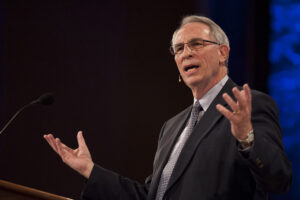
ALEXANDRIA, La. (BP)–The term “pro-choice” in relation to abortion was first used in the mid-1970s, the result of “sloganeering to avoid the harness of ‘pro-abortion,'” observed journalist and columnist William Safire.
Supporting a woman’s ability to “choose” sounds much better from a public relations stand point than arguing for her right to an abortion. The most ardent advocates of abortion believe a woman should be able to “choose” an abortion for any reason and at any time during pregnancy — no limits.
After more than 30 years, the mantra of “choice” has not only gone around the world, but with the advent of amniocentesis and ultrasound, the reasons women “choose” abortion have greatly expanded.
In the U.S., around 90 percent of babies diagnosed with Down Syndrome in the womb are aborted. Meanwhile, some women pregnant with multiples now choose to abort one or more of the babies, even if all are healthy.
Another troubling trend is sex-selective abortion. In many countries, healthy unborn baby girls are having their lives snuffed about because, according to their parents, they are the wrong sex.
The consequences of sex-selective abortion are exposed in a new book, “Unnatural Selection,” by researcher Mara Hvistendahl.
“For as long as they have counted birth,” writes Hvistendahl, “demographers have noted that an average of 105 boys are born for every 100 girls.”
While the average can vary ever so slightly, any significant skewing of the ratio is due to unnatural causes.
“That extra 5 percent of boys compensates, as the German statistician Johann Peter Sussmilch observed in 1741, ‘for the higher male losses due to the recklessness of boys, to exhaustion, dangerous tasks, or migration,'” writes Hvistendahl.
As one who believes God is the creator and sustainer of life, I view the universality of the natural sex ratio as the Lord’s provision for sustained procreation.
Currently in China, there are 121 boys born for every 100 girls — though there are regions where the number tops 150. In India the ratio is 112 males for every 100 females. The two most populous nations on the earth skew the average worldwide sex ratio to a 107 boys to every 100 girls.
Asia is not alone in its pronounced gender imbalance. Hvistendahl found that Azerbaijan has a sex ratio of 115 males to every 100 females, the Republic of Georgia stands at 118 and Armenia at 120.
A conservative estimate, according to Hvistendahl, is that in the last 30 years 163 million females in Asia alone have been victims of sex selective abortion. That’s more than the female population in the United States.
Western feminists blame male-dominated cultures for sex-selective abortions. While the cultures with the most alarming sex ratios do put a premium on producing boys, Hvistendahl found the overwhelming choice for aborting an unborn girl was made by the pregnant women and sometimes the mother-in-law.
Others point to poverty as the root cause for sex-selective abortion. However, Hvistendahl found that it was a country’s rich, not its poor, that first embraced the concept. “Sex selection typically starts with the urban, well-educated stratum of society,” she writes. The behavior then trickles down until it is accepted by the broader culture.
A society with more males doesn’t bode well for females, or males, according to Hvistendahl. Women will become a commodity, and — with a lack of males — young girls in developing countries are likely to be sold off to provide income for the family.
Another consequence of the skewed sex rate is crime. According to Hvistendahl, the best predictor of crime in certain Chinese provinces and India is sex ratio, not economics. Where the male sex ratio has spiked, crime has followed.
“Historically, societies in which men outnumber women are not nice places to live,” Hvistendahl writes. “Often they are unstable. Sometimes they are violent.”
To put things in perspective, Hvistendahl notes that worldwide, during the same time period, AIDS has claimed an estimated 25 million people — far fewer than the estimated number of sex-selective abortions (163 million).
“AIDS has the attention of non-governmental organizations, policymakers and school children around the world. It boasts its own United Nations agency,” she writes. “Sex selection remains mostly invisible, however, a more pervasive and yet quieter epidemic….”
Why the silence when it comes to sex selective abortion? Where are the feminists and activists speaking out on the practice? It is because their worldview is rooted in choice — no limits.
Though sex-selective abortion is not thought to be taking place in great numbers in the United States, there is nothing to keep it from happening.
If “my body, my choice” is the argument for abortion, then there is no choice that is not valid. If abortion is only about a woman’s choice, then aborting a baby because of gender is as valid a reason as any other.
The term “pro-choice” might have been a public relations move to place abortion-on-demand in a more favorable light. However, the practice of abortion-by-choice has resulted in the death of millions of precious babies, many of them girls.
“But in the end, this is a book not about life and death but about the potential for life — and denying that potential for the very group responsible for perpetuating our beleaguered species,” Hvistendahl writes.
Could it be we are in the process of aborting ourselves to death? If so, it will be because of choice — unfettered, unlimited choice.
–30–
Kelly Boggs is a weekly columnist for Baptist Press and editor of the Baptist Message (www.baptistmessage.com), newsjournal of the Louisiana Baptist Convention.














